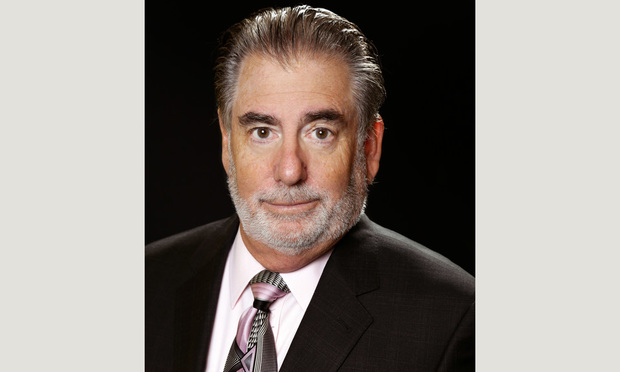There's No Place for Egos in Collaborative Divorce
A collaborative divorce, while still difficult because it deals with ending a marriage, is a peacemaking process to keep civility between the parties so they can work more closely together after the process.
June 12, 2019 at 09:52 AM
5 minute read
 Jeffrey P. Wasserman, shareholder with Shapiro, Blasi, Wasserman & Hermann.
Jeffrey P. Wasserman, shareholder with Shapiro, Blasi, Wasserman & Hermann.
As a case looms, it has become instinctive for litigators to ready themselves for a fight. While litigation is not, by definition, combative, it certainly is by practice. But in divorce, the inclination to fight tooth and nail for every element where there is a disagreement has turned once-happy families, albeit recognizing the dissolution of their union, into a family feud. A collaborative divorce, while still difficult because it deals with ending a marriage, is a peacemaking process to keep civility between the parties so they can work more closely together after the process. First, however, the egos of the attorneys involved must be held in check—their natural desire to win at all costs must be replaced by the needs of the clients to resolve the issues as amicably as possible—and by doing so, preserve the often-fragile remnants of the family dynamic.
Collaborative lawyers are trained to adopt a paradigm shift, and to be wary of the predisposition to fight. For litigators, this is a mighty effort—but well worth it for the parties seeking a harmonious split.
A paradigm shift is defined as a “fundamental change in approach or underlying assumptions.” For family lawyers who have long been litigators, as I was, it boils down to several elements— changing the focus away from battle, becoming a peacemaker when agreement seems unlikely, and altering the method of reaching a goal.
One thing that stands out is that litigating attorneys often give in to their egos, making the case as much about their success as it is about the success they want to achieve for clients. While transitioning to a nonlitigious role may seem to be a major modification of the personality of a litigator, and it is, it is in fact more of a major adjustment in methodology.
Collaborative family lawyers must twist their heads around 180 degrees and suddenly become a nice person in dealing with every member of the team. Again, this is part of the aforementioned paradigm shift. The attorneys must also become flexible, listen better, be nonpositional as well as nonconfrontational, and understand that they are merely one element of the on-going process, and not necessarily the most important component of the team and the entire situation.
Collaborative law starts out wholly different from litigation. A highly meaningful element is the initial prebrief where all the professional team members assemble, either in person or via phone conference, to discuss the basic terms of the process at hand and the goals of the husband and wife. It is critical to remember that no professional is more important than any other. Each has a role to play in reaching a successful conclusion of the matter.
Collaboration can begin with very basic issues, such as where meetings will take place, the accommodations at the location and even the seating arrangement. Resolution on these simple but crucial premises is vital to helping ensure a smooth flow in the proceedings to come. For example, if there is confusion over the seating arrangement when everyone enters the conference room, the start of the process can be chaotic. If either of the attorneys insist on sitting at the “head of the table,” this can send a message that one attorney believes he is more important than everyone else in the room, which clearly creates an immediate imbalance in the eyes of the parties. This is not an acceptable beginning to a collaborative process.
When the collaborative process involves a neutral facilitator, this is the professional who should be seated at the head of the table, if there is indeed a head of the table. The facilitator, being a neutral, keeps things in balance for the parties and the process. The facilitator can also keep a closer eye on everyone to make sure the body language and spoken language are appropriate and not interfering with a successful conclusion. Regardless of the location—even in my own office—I have always yielded the head of the table to the facilitator—and that has made a difference in the smooth forward motion.
Each case proceeds differently but one thing that is always necessary is the proper comportment of the attorneys involved. It takes a lot to check one's ego at the door. But a husband and wife, looking to become exes without vitriol, do not need lawyer bravado. They need support, advice, counsel and not anger, hostility, and a lawyer stoking the flames that may be under the radar.
We've been hearing about civility and professionalism in the courthouse for years. Litigators can take a page out of the collaborative family lawyers' book, reduce the friction that has become commonplace, and perhaps see a way to collaborate in other areas of law.
Jeffrey P. Wasserman is a shareholder with Shapiro, Blasi, Wasserman & Hermann, and leads the firm's family law practice group. He has served as chair of the family law section of the Florida Bar. He is currently developing a practice in collaborative law, focusing on peacemaking and keeping clients out of court. Contact him at 561-477-7800 or [email protected].
This content has been archived. It is available through our partners, LexisNexis® and Bloomberg Law.
To view this content, please continue to their sites.
Not a Lexis Subscriber?
Subscribe Now
Not a Bloomberg Law Subscriber?
Subscribe Now
NOT FOR REPRINT
© 2025 ALM Global, LLC, All Rights Reserved. Request academic re-use from www.copyright.com. All other uses, submit a request to [email protected]. For more information visit Asset & Logo Licensing.
You Might Like
View All
Don’t Forget the Owner’s Manual: A Guide to Proving Liability Through Manufacturers’ Warnings and Instructions
5 minute read


Leveraging the Power of Local Chambers of Commerce: A Second-Career Lawyer’s Guide to Building a Thriving Practice
5 minute readTrending Stories
- 1How ‘Bilateral Tapping’ Can Help with Stress and Anxiety
- 2How Law Firms Can Make Business Services a Performance Champion
- 3'Digital Mindset': Hogan Lovells' New Global Managing Partner for Digitalization
- 4Silk Road Founder Ross Ulbricht Has New York Sentence Pardoned by Trump
- 5Settlement Allows Spouses of U.S. Citizens to Reopen Removal Proceedings
Who Got The Work
J. Brugh Lower of Gibbons has entered an appearance for industrial equipment supplier Devco Corporation in a pending trademark infringement lawsuit. The suit, accusing the defendant of selling knock-off Graco products, was filed Dec. 18 in New Jersey District Court by Rivkin Radler on behalf of Graco Inc. and Graco Minnesota. The case, assigned to U.S. District Judge Zahid N. Quraishi, is 3:24-cv-11294, Graco Inc. et al v. Devco Corporation.
Who Got The Work
Rebecca Maller-Stein and Kent A. Yalowitz of Arnold & Porter Kaye Scholer have entered their appearances for Hanaco Venture Capital and its executives, Lior Prosor and David Frankel, in a pending securities lawsuit. The action, filed on Dec. 24 in New York Southern District Court by Zell, Aron & Co. on behalf of Goldeneye Advisors, accuses the defendants of negligently and fraudulently managing the plaintiff's $1 million investment. The case, assigned to U.S. District Judge Vernon S. Broderick, is 1:24-cv-09918, Goldeneye Advisors, LLC v. Hanaco Venture Capital, Ltd. et al.
Who Got The Work
Attorneys from A&O Shearman has stepped in as defense counsel for Toronto-Dominion Bank and other defendants in a pending securities class action. The suit, filed Dec. 11 in New York Southern District Court by Bleichmar Fonti & Auld, accuses the defendants of concealing the bank's 'pervasive' deficiencies in regards to its compliance with the Bank Secrecy Act and the quality of its anti-money laundering controls. The case, assigned to U.S. District Judge Arun Subramanian, is 1:24-cv-09445, Gonzalez v. The Toronto-Dominion Bank et al.
Who Got The Work
Crown Castle International, a Pennsylvania company providing shared communications infrastructure, has turned to Luke D. Wolf of Gordon Rees Scully Mansukhani to fend off a pending breach-of-contract lawsuit. The court action, filed Nov. 25 in Michigan Eastern District Court by Hooper Hathaway PC on behalf of The Town Residences LLC, accuses Crown Castle of failing to transfer approximately $30,000 in utility payments from T-Mobile in breach of a roof-top lease and assignment agreement. The case, assigned to U.S. District Judge Susan K. Declercq, is 2:24-cv-13131, The Town Residences LLC v. T-Mobile US, Inc. et al.
Who Got The Work
Wilfred P. Coronato and Daniel M. Schwartz of McCarter & English have stepped in as defense counsel to Electrolux Home Products Inc. in a pending product liability lawsuit. The court action, filed Nov. 26 in New York Eastern District Court by Poulos Lopiccolo PC and Nagel Rice LLP on behalf of David Stern, alleges that the defendant's refrigerators’ drawers and shelving repeatedly break and fall apart within months after purchase. The case, assigned to U.S. District Judge Joan M. Azrack, is 2:24-cv-08204, Stern v. Electrolux Home Products, Inc.
Featured Firms
Law Offices of Gary Martin Hays & Associates, P.C.
(470) 294-1674
Law Offices of Mark E. Salomone
(857) 444-6468
Smith & Hassler
(713) 739-1250






